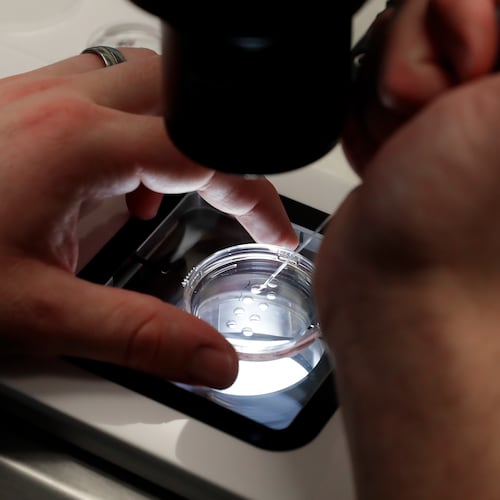California-based developer CIM Group envisions a mini-city in Atlanta’s Gulch.
It's a project that has the potential to transform downtown. But it's also a project that comes with a big price tag: up to $5 billion to construct the mixed-use complex, with the developer asking for up to $1.9 billion in public financing.
While Atlanta Mayor Keisha Lance Bottoms argues the deal is structured in such a way that all risk is on CIM, some City Council members and vocal critics remain unconvinced.
Here’s what you need to know as council considers the proposal:
Who are the developers? CIM and the Atlanta Hawks. CIM was founded by Richard Ressler. His brother, Tony, is the lead owner of the Hawks. CIM committed to having 10 percent ownership go to minority-owned interests, which haven't been identified.
What are the details on the project? The development will consist of office space equal to seven Bank of America Plazas, 1,000 residences, 1,500 hotel rooms and a regional mall's worth of retail space. The Gulch is a field of parking lots and rail lines below surrounding viaducts. To make the site feasible, CIM says a massive $500 million steel and concrete platform is needed to raise the site above the active rail lines, about 40 feet, to street level. The city can't afford to build it, so CIM said it will front that money. That will create up to 15 new city blocks that will be publicly accessible, but will be owned by the developer. In return, CIM wants future tax revenue to help guarantee investor returns.
What community benefits will CIM commit to? A $28 million investment in a citywide affordable housing trust fund, along with setting aside as affordable housing 200 of the residential units built at the site — or 20 percent of the total built, whichever is greater — for 99 years. (CIM would have the ability to sell the affordable units as price-controlled condos after three years of rental, or sell the units to the city to retain them as subsidized rentals.) The developer also agrees to give $12 million toward an economic development fund; $12 million for a new fire station; $2 million to a workforce program. CIM will provide space for an Atlanta police mini-precinct and will agree to 38 percent minority-and women-owned business participation in the construction of the complex.
What will Atlanta and the state have to commit to? CIM and its partners would be able to tap into future sales and property taxes created on site to help fund development. It's a first-of-its-kind public financing package in Atlanta that could equal about $1.9 billion in bonds and reimbursements, not including interest, through 2048. Those tax dollars normally would be paid to the state, city, Fulton County and Atlanta Public Schools. Project supporters say the city doesn't really lose anything because the tax revenue only exists because of the project.
The developers, not the city, would be on the hook if tax revenue doesn’t pay off bonds that will fund a portion of the incentives.
Critics say the city, county and schools risk losing money because any new development that ends up in the Gulch would’ve gone somewhere else in Atlanta if the mixed-use complex never existed.
CIM can collect 5 cents of the 8.9-cent local sales taxes generated within the Gulch through 2048. Four of those five pennies are from the state. The other penny normally would be shared by the city, county and other municipalities in Fulton. (CIM says the other 3.9 pennies would be a new windfall of sales tax revenue.)
CIM said the project could create enough sales tax money to fund repayment of up to $1.25 billion in bonds, including interest.
The second revenue stream comes from Gulch property taxes collected through a special taxing area known as the Westside Tax Allocation District (TAD) through 2038. A TAD is a zone where governments freeze property tax collections to the value of the property before development and use future expected increases in values to fund infrastructure and development.
As CIM constructs new buildings, the property values — and taxes it pays into the TAD — will rise.
CIM can obtain bond financing of $32 million up front. Overall, the TAD can reimburse CIM up to 12.5 percent of total project costs for a maximum of $625 million through 2038. CIM must meet certain thresholds to tap into those funds.
Any Gulch property tax revenue greater than $625 million would stay in the TAD to incentivize other Westside projects through 2038, or go to the city, county and schools after the TAD expires.
If the project meets its full potential, the state’s share of sales tax money would be the largest individual source of public revenue. If not, future property tax revenue could make up a larger share.
Are these figures realistic? Bottoms' administration and CIM say they are. But brick-and-mortar retail is challenged by the rise of e-commerce. It's also a speculative project, and nothing is guaranteed.
A report commissioned by the city from Municap, a bond consultant, raises doubts about whether the developer can create enough sales tax to fund principle and interest payments on $1.25 billion in bonds. Municap found that the five pennies of sales taxes within the development would create $661 million in funding over 30 years. That’s enough money to finance about $350 million in bonds, Emory University Finance Lecturer Ray Hill said.
The city has said the Municap report is very conservative, and CIM officials have said the believe they can create a destination that generates far more sales tax revenue.
As for the TAD, Municap forecasts the project will create about $645 million in property taxes through 2038.
But some say the Municap report understates the full potential Gulch property tax revenue. The report values new buildings at far below the cost of new construction, meaning much more property tax money could flow into the TAD if CIM builds what it plans. If so, that could be a benefit to Westside neighborhoods.
How would the public money be used? The sales tax money would finance infrastructure, such as the platform and street grid. The future property tax dollars can be used to help construct Gulch infrastructure and buildings.
How long will it take before the complex is up and running? The platform is expected to take three to four years to build, and development is likely to take more than a decade.
Are there tenants for the project? None announced. The development is speculative. The site has been pitched to Amazon for its second headquarters, but CIM and its partners have said they will go forward with the project if Amazon doesn’t bite.
Is Norfolk Southern's HQ going to the Gulch? No. The railroad owns Gulch land CIM wants to buy. Norfolk Southern wants to use the proceeds to fund a new headquarters. That new HQ could go to Midtown.
Will the Gulch project create 35,000 permanent jobs? Supporters tout that number, but the project itself won't create those jobs — tenants will. There are no guarantees 35,000 workers will be employed there, nor is there a guarantee all of the Gulch jobs will new jobs. Some tenants likely will be new to the region, but local companies might choose to relocate from other parts of metro Atlanta to the Gulch.
CIM Chairman Richard Ressler said, "Taxpayers will pay nothing for this development." Is that true? It's misleading. For starters, sales taxes from within the Gulch will directly fund infrastructure. Also, the vast majority of property taxes Gulch developers normally would pay to the city, county and schools will be redirected to help fund development. In projects built outside a TAD, those forgone tax dollars would go to government coffers.
How many affordable residences will the $28 million donation create? If strictly dedicated to construction, about 100 or so new units. Bottoms previously told the AJC the money would help create 500 units (or a subsidy of $56,000 per unit). A lawyer for the city recently said 2,000 units could be created (or $14,000 per unit). The 2,000-unit figure takes some explaining. Bottoms' office said that could come from leveraging the funds through programs such as down payment assistance, multifamily gap financing loans and certain infrastructure grants.
Does this plan include a downtown multi-modal passenger terminal? The Gulch site spans two MARTA stations, Five Points and the one at CNN Center, making it arguably the best transit-connected location in the city. Though the site plan preserves the ability to establish potential future commuter rail there at some point, a new terminal isn’t on the drawing board. The Gulch long has been envisioned as the place for a new terminal station and hub for MARTA trains, commuter rail, potential AMTRAK service and buses. But lack of support at the state and city have stalled any momentum for a downtown passenger terminal. The project suffered a significant blow in 2013 when Norfolk Southern wrote a letter to state transportation leaders asserting it did not have space on its tracks to spare for commuter rail service.
OUR REPORTING
The AJC first reported that the city and CIM Group were engaged in private talks about a potential 10-figure public financing package for the Gulch project. AJC reporters have looked at the potential costs and community benefits of the up-to-$5 billion project that could remake 40 acres of downtown Atlanta. The City Council is scheduled to hold a work session Tuesday at 9:30 a.m. on the matter. A formal vote could take place on Nov. 5.
About the Author
Keep Reading
The Latest
Featured






